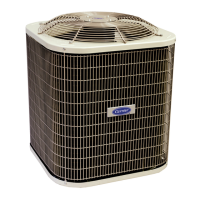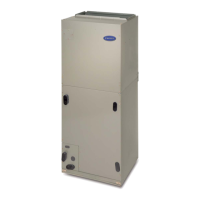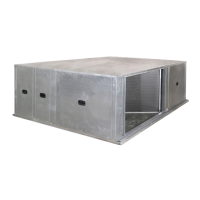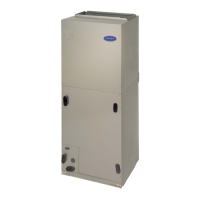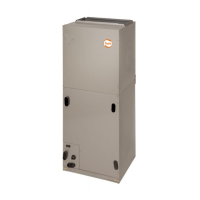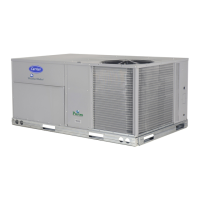6
Table 3 – Standard Control
MODE
DEHUMIDISTAT
POSITION
OPERATION
DAMPER
POSITION
FAN SPEED ON LED
AIR EXCHANGE
LED
Off Any Off Closed to outside Off Off Off
Low
Satisfied
Air exchange with
outside
Open to outside
Low
On
Off
Call for dehumidification On
Intermittent
Satisfied
High
Off
Call for dehumidification On
Table 4 – Automatic Control
MODE
DEHUMIDISTAT
POSITION
OPERATION
DAMPER
POSITION
FAN
SPEED
INDICATOR LEDS
Off Any Off Closed to outside Off Off
Intermittent
Satisfied
Air exchange with outside Open to outside
Off Intermittent ON
Call for dehumidification High Intermittent and Exchange ON
Continuous
Satisfied Low
Continuous and Exchange ON
Call for dehumidification High
Recirculation
Satisfied Recirculation Closed to outside High Recirculation ON
Call for dehumidification Air exchange with outside Open to outside High Recirculation and Exchange ON
Any Any Any Any Maintenance (open door)
NOTE: This control is designed to be used primarily with
installations which are independent of a forced air system.
1. Initially the switch is off. All LEDs are of f and HRV is
inoperative
2. First push of mode button puts HRV into intermittent mode.
The HRV operates at high speed when there is a call for
dehumidification. Intermittent and exchange LEDs are
illuminated. When dehumidistat is satisfied, HRV shuts
down and exchange LED goes out.
3. Next push of mode button puts system in continuous mode.
Continuous and exchange LEDs remain on. The HRV
operates at high -- speed blower during calls for
dehumidification and low--speed when dehumidistat is
satisfied.
4. Next push of mode button and exchange puts system in
circulation mode. HRV operates in high speed at all times.
Circulation LED remains on. When there is a call for
dehumidification, exchange LED is on and HRV exchanges
air with outside. When dehumidistat is satisfied, HRV
dampers close which recirculates indoor air. The exchange
LED goes off.
5. The maintenance light illuminates every 3 months to
indicate filter should be cleaned. It is reset by opening the
door to the HRV.
NOTE: The standard and automatic controls sense humidity not
temperature. Either control must be located in an area where it will
continually monitor fresh air circulating within the home. Install
HRV wall control as close as possible to main system thermostat
and follow same guidelines as installing a thermostat, (locate
approximately 5 ft. (1.5 m) above floor, mount on an inside
partitioning wall, etc.).
NOTE: The HRV may be controlled using the Infinity System
Control. The HRV may be connected using either a NIM or a
4--Zone Damper Module. See the appropriate instructions if using
the NIM of a 4 -- Zone Damper Module for connection instructions.
Blower interlock relay is not needed for use with the Infinity
system control. The Infinity System Control will simultaneously
control the HRV and the indoor blower.
Push Button Timers may be used and are connected to the HRV as
shown in Fig. 12. However, the Infinity system should be set to
continuous fan to ensure that the fresh air is circulated in the home.
In a Zoned System, at least one zone should be set to continuous
fan.
3
4
5
I
OC
OL
YELLOW
BLACK
RED
ELECTRONIC CONTROL
BOARD
BACK OF PUSH BUTTON SWITCH
J3
J1
6
7
8
9
41 7
52 8
63 9
BLACK – (J3- 4)
COMMON
TERMINAL
STRIP
YELLOW – (J3- 3)
INDICATOR
TERMINAL STRIP
RED – (J3- 5)
SWITCH
TERMINAL STRIP
BLACK – COMMON, (J3--4)
YELLOW – INDICATOR, (J3--3)
THE WIRES FROM THE SWITCH
RED – SWITCH, (J3-- 5)
(OC)
(I)
(OL)
(OPTIONAL)
60 MINUTE TIMER
(OPTIONAL)
PUSH BUTTON SWITCHES
(5 SWITCHES MAXIMUM)
A98386
Fig. 12 -- Push Button Timer Wiring Layout
OPERATING THE HRV WITH THE
INFINITY CONTROL
The ventilator has four settings in heating mode and three settings
in cooling mode.
Heating:
AUTO -- the ventilator selects the speed based on indoor humidity
and outdoor temperature. It may cycle on/off every 30 minutes
depending on humidity and outside temperature.
LOW -- low speed all of the time.
HIGH -- high speed all of the time.
DEHUM -- will only turn on if humidity is 3% over setpoint. The
speed is determined by indoor humidity and outdoor temperature.
HRV

